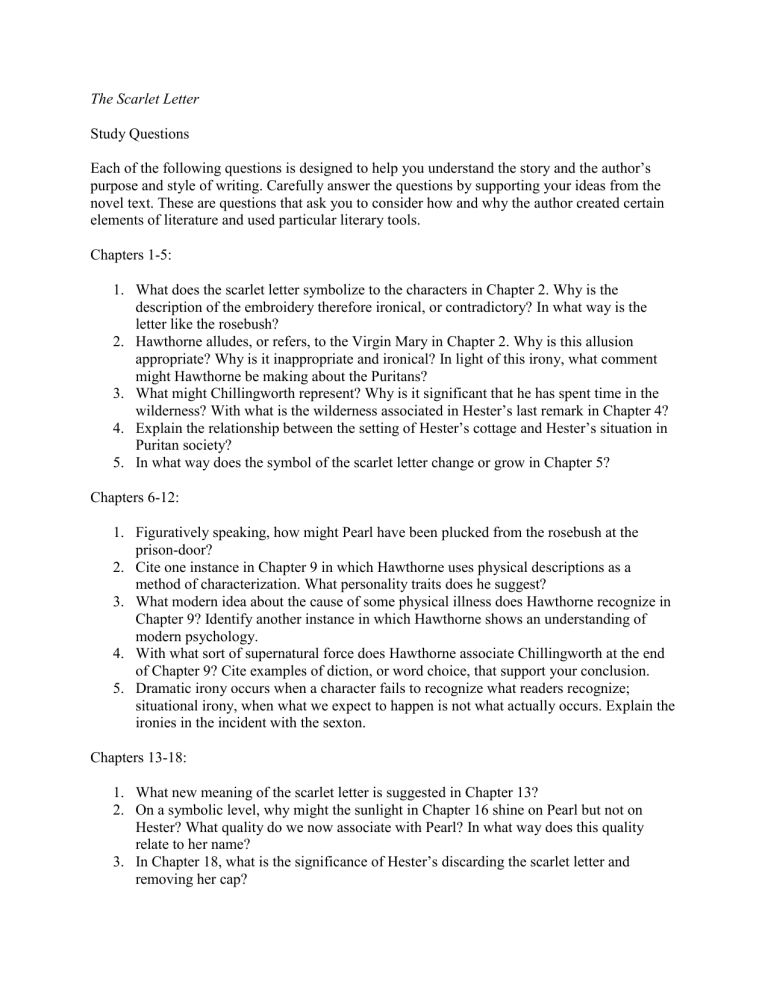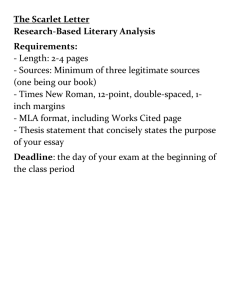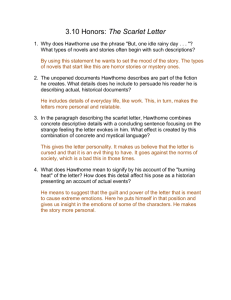The Scarlet Letter Study Questions Each of the following questions

The Scarlet Letter
Study Questions
Each of the following questions is designed to help you understand the story and the author’s purpose and style of writing. Carefully answer the questions by supporting your ideas from the novel text. These are questions that ask you to consider how and why the author created certain elements of literature and used particular literary tools.
Chapters 1-5:
1.
What does the scarlet letter symbolize to the characters in Chapter 2. Why is the description of the embroidery therefore ironical, or contradictory? In what way is the letter like the rosebush?
2.
Hawthorne alludes, or refers, to the Virgin Mary in Chapter 2. Why is this allusion appropriate? Why is it inappropriate and ironical? In light of this irony, what comment might Hawthorne be making about the Puritans?
3.
What might Chillingworth represent? Why is it significant that he has spent time in the wilderness? With what is the wilderness associated in Hester’s last remark in Chapter 4?
4.
Explain the relationship between the setting of Hester’s cottage and Hester’s situation in
Puritan society?
5.
In what way does the symbol of the scarlet letter change or grow in Chapter 5?
Chapters 6-12:
1.
Figuratively speaking, how might Pearl have been plucked from the rosebush at the prison-door?
2.
Cite one instance in Chapter 9 in which Hawthorne uses physical descriptions as a method of characterization. What personality traits does he suggest?
3.
What modern idea about the cause of some physical illness does Hawthorne recognize in
Chapter 9? Identify another instance in which Hawthorne shows an understanding of modern psychology.
4.
With what sort of supernatural force does Hawthorne associate Chillingworth at the end of Chapter 9? Cite examples of diction, or word choice, that support your conclusion.
5.
Dramatic irony occurs when a character fails to recognize what readers recognize; situational irony, when what we expect to happen is not what actually occurs. Explain the ironies in the incident with the sexton.
Chapters 13-18:
1.
What new meaning of the scarlet letter is suggested in Chapter 13?
2.
On a symbolic level, why might the sunlight in Chapter 16 shine on Pearl but not on
Hester? What quality do we now associate with Pearl? In what way does this quality relate to her name?
3.
In Chapter 18, what is the significance of Hester’s discarding the scarlet letter and removing her cap?
4.
Do you think Hawthorne approves of Hester’s plans for herself and the minister? Cite details to support your answer.
5.
What is the symbolic contrast between the forest and the Puritan community? What is contradictory about the symbol of the forest? What might be the explanation of this apparent contradiction?
Chapters 19-24:
1.
What does Pearl’s behavior toward Dimmesdale in Chapter 19 suggest about the morality of Dimmesdale’s decision? Explain.
2.
What is the symbolic meaning of Chillingworth’s remark in Chapter 23, “Thou hast escaped me”?
3.
What does Dimmesdale’s scarlet letter represent? How does it become like Hester’s in
Chapter 23?
4.
Hawthorne states one of his themes in his conclusion. What is the theme, or moral lesson? Explain the moral.
5.
An escutcheon is part of coat of arms, a sign of high rank. When a herald records a family’s coat of arms, he uses words similar to those that close the novel. Why might
Hawthorne give Hester and Arthur an escutcheon on their tombstone? By using the herald’s word gules instead of scarlet, what does Hawthorne imply has happened to the characters?




